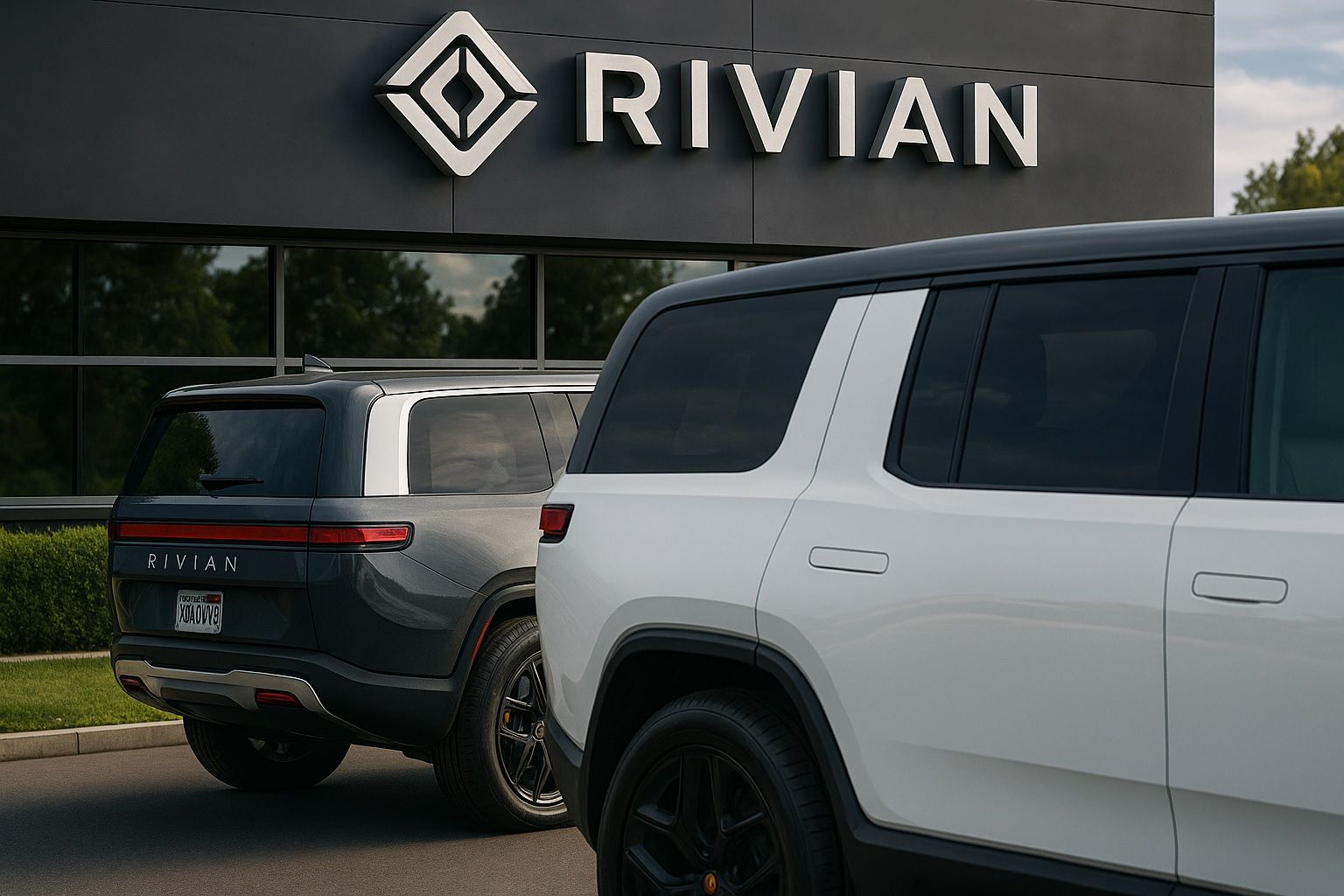Rivian Automotive (NASDAQ: RIVN) is back in the headlines this Thursday as investors digest fresh news on its high‑stakes partnership with Volkswagen, a controversial multi‑billion‑dollar CEO pay package, and new disclosures showing big institutions both trimming and adding to positions.
As of the latest quote around midday UTC, Rivian shares trade near $17.52, down a couple of percent from yesterday’s close and still sitting close to their recent 52‑week high above $18. [1] That comes after a ferocious rally of roughly 40% since November 4, when Rivian reported a stronger‑than‑expected third quarter and unveiled a massive new incentive plan for CEO RJ Scaringe. [2]
At the same time, today’s news flow highlights just how divided the market remains on RIVN: some institutions are cashing out, others are doubling down, and analysts still see downside from current levels.
Rivian stock price snapshot for November 13, 2025
- Last price: about $17.52 per share
- Move vs previous close: roughly 2–3% lower, a modest pullback after last week’s surge
- 52‑week range: $9.55 – $18.13, keeping RIVN near the top of its one‑year trading band [3]
- Market cap: around $21–22 billion, depending on the exact intraday quote [4]
Even after today’s early weakness, Rivian stock is up about 40% from a closing price near $12.50 on November 4, the day before its Q3 earnings pop. [5] That makes it one of the hotter names in the EV complex this month – but also raises the stakes if sentiment turns.
Today’s biggest story: The Volkswagen–Rivian tech alliance gets bigger
The most important November 13 headline for Rivian doesn’t come from Detroit or Wall Street – it comes from Germany.
1. JV tech that might outgrow EVs
Volkswagen Group says its joint venture with Rivian, known as RV Tech, could eventually be used not only in electric vehicles but also in combustion‑engine cars, extending Rivian’s software and electronics architecture far beyond its own lineup. [6]
Key points from today’s reporting:
- VW and Rivian are co‑developing a scalable, next‑generation software and electronics platform that will sit at the heart of future VW Group vehicles. [7]
- By the end of the decade, more VW models riding on the company’s Scalable Systems Platform are expected to use this joint architecture. [8]
- While it is being built for EVs first, VW now says the platform could be adapted to ICE models, which would dramatically expand its addressable market. [9]
For Rivian, the JV is backed by up to $5.8 billion of Volkswagen investment, providing both cash and validation at a time when many legacy carmakers are cutting back on EV ambitions. [10]
2. Rivian’s software for sale
A separate piece of today’s coverage digs into the JV’s business model: selling the platform to other automakers.
An article syndicated via CryptoPolitan explains that VW and Rivian plan to license their EV software and architecture to third parties, not just use it internally. [11]
Rivian’s software chief, Wassym Bensaid, describes the effort as solving a problem for the wider auto industry, with the platform designed to scale across multiple body styles and brands. [12] Crucially, he notes that licensing income would carry a “very different margin profile” from building and selling cars – exactly the kind of higher‑margin revenue stream investors like to see from a capital‑intensive manufacturer.
Winter testing of the RV Tech platform is scheduled for early 2026 on vehicles from Audi, Volkswagen and Scout, with Rivian’s R2 SUV expected to be the first product to launch using the architecture. [13]
Why it matters for the stock:
- The JV deepens a strategic tie‑up with a global giant at the same time Rivian is fighting tariff and demand headwinds. [14]
- If licensing gains traction, Rivian could add asset‑light software revenue on top of vehicle sales.
- Today’s headlines reinforce the idea that the Volkswagen deal is more than a one‑off capital injection – it’s evolving into a long‑term platform story.
Fresh 13F headlines today: who’s selling Rivian, who’s buying?
The other major theme on November 13 is institutional positioning. Two new MarketBeat “instant alerts” filed today show some big long‑only investors lightening up – even as other firms have recently increased exposure. [15]
Aviva PLC slashes its stake
- UK insurer Aviva PLC cut its position in Rivian by more than 60% in the second quarter, selling roughly 968,800 shares. [16]
- After the sale, Aviva holds about 586,000 shares, representing roughly 0.05% of Rivian’s outstanding stock. [17]
Bank of New York Mellon trims as well
- Bank of New York Mellon Corp reduced its Rivian holdings by about 12.6%, selling more than 400,000 sharesduring Q2. [18]
- The custodian bank still owns around 2.8 million shares worth just under $40 million, or about 0.25% of Rivian. [19]
But others are doubling down
This selling is counterbalanced by more aggressive buyers:
- A new TipRanks report notes that Citigroup added about 4.95 million shares in Q3, more than doubling its stake to 8.54 million shares, its largest position in Rivian since the 2021 IPO. [20]
- Quiver Quantitative data show a mixed but very active institutional picture: hundreds of hedge funds increased positions in recent quarters, while a similar number reduced them. [21]
Taken together, today’s 13F‑driven headlines underline a simple truth: Rivian has become a conviction battleground for big money. Some managers are taking profits after the post‑earnings spike, while others are treating the same volatility as an entry point.
Why Rivian stock ran so hard before today: Q3 earnings and CEO pay
To understand today’s more cautious trading, it helps to rewind to what sent RIVN rocketing higher over the past week.
Q3 2025: tax‑credit rush and first gross profit
Rivian’s third‑quarter numbers, released on November 4, were better than feared on almost every key line: [22]
- Revenue: about $1.56 billion, beating estimates near $1.5 billion and rising roughly 78% year over year.
- Deliveries: 13,201 vehicles, up about 32% from the same quarter in 2024, helped by buyers rushing to lock in the soon‑to‑expire $7,500 U.S. EV tax credit. [23]
- Profitability: Rivian reported its first‑ever positive gross profit, roughly $24 million, even though it remains deeply loss‑making at the bottom line. [24]
- Net loss: adjusted loss per share of around $0.65, narrower than consensus forecasts that were closer to a $0.72 loss. [25]
- Guidance: the company reaffirmed full‑year delivery guidance of 41,500–43,500 vehicles and kept 2025 adjusted EBITDA loss guidance near $2 billion, despite warning that Q4 would look “funky” as demand normalises after the tax‑credit pull‑forward. [26]
Rivian also reiterated plans to launch its R2 crossover – a smaller, roughly $45,000 SUV aimed at a broader market – in 2026, backed by a new $5 billion plant in Georgia and upgrades to its Normal, Illinois facility. [27]
A Tesla‑style $4.6 billion CEO package
Layered on top of the earnings surprise was a headline‑grabbing overhaul of CEO RJ Scaringe’s compensation:
- Rivian cancelled his 2021 performance option grant and replaced it with a new 2025 CEO Award giving him the right to buy up to 36.5 million shares at an exercise price of $15.22 – roughly where the stock traded before the announcement. [28]
- The package, which could be worth up to $4.6 billion if all targets are hit, vests in tranches tied to ambitious share‑price hurdles (roughly $40–$140) and operating metrics such as adjusted operating income and cash flow. [29]
- At the same time, the board doubled Scaringe’s base salary from $1 million to $2 million and awarded him a 10% economic interest in a new robotics subsidiary, Mind Robotics, through 1 million fully vested units. [30]
Supporters see the package as a Tesla‑style bet on transformational upside, tightly linking Scaringe’s payout to shareholder value creation. Critics worry about potential dilution and the optics of a huge pay deal while the company is still posting heavy losses.
Insider selling keeps the debate alive
That debate was sharpened by a new SEC filing showing Scaringe selling 52,350 shares of common stock for about $869,000, on top of multiple smaller sales in recent months. [31] QuiverQuant data show that over the last six months, Rivian insiders have made only sales and no open‑market purchases, with Scaringe and CFO Claire McDonough together disposing of nearly 250,000 shares. [32]
For some traders, the combination of a giant new options grant plus continued insider selling is a yellow flag, even as the operational story improves.
Wall Street’s verdict on RIVN after the rally
Despite the recent pop, analyst sentiment on Rivian is still cautious overall.
Consensus: “Hold” with downside to targets
- MarketBeat data compiled this week show a consensus “Hold” rating, with 5 Buys, 16 Holds and 5 Sells, and an average 12‑month price target around $13.8 – more than 20% below where the stock trades today. [33]
- A separate TipRanks roundup gives a similar average target near $13–14 and also labels the stock a Hold, with projected downside in the low‑20% range from current prices. [34]
In other words, even after Rivian’s better‑than‑expected quarter, most analysts do not think today’s price fully squares with near‑term fundamentals.
Recent rating moves you should know about
- DA Davidson raised its price target from $13 to $15 earlier this week, but kept a Neutral rating, explicitly noting that its new target still sits below the market price after the rally. [35]
- Goldman Sachs recently cut its target to $13 while maintaining a neutral stance, citing execution risk and ongoing cash burn. [36]
- Mizuho downgraded Rivian with a $10 target, flagging softer EV demand and geopolitical risks. [37]
- On the bullish side, Canaccord Genuity has a $21 target and a Buy rating, arguing that Rivian’s growth, cash runway and product roadmap justify a premium. [38]
The net effect: sharply divided views, with aggressive upside targets in the low‑20s at one end and single‑digit downside targets at the other.
Fundamentals after Q3: progress, but still plenty of risk
The numbers behind the story paint a nuanced picture.
What’s improving
- Revenue scale: Trailing‑twelve‑month revenue now sits near $5 billion, up from almost nothing a few years ago, with 2025 sales expected to be in the $4.7–4.9 billion range despite a tricky demand backdrop. [39]
- Gross profit: Rivian has now delivered multiple quarters of positive gross profit, an important milestone for a fast‑growing manufacturer. [40]
- Cost controls: Management says tariff costs per vehicle have already been cut from “a few thousand” dollars to “a few hundred,” thanks to policy changes and supply‑chain work. [41]
- Cash runway: Between its balance‑sheet cash (over $7 billion) and the Volkswagen funding, Rivian still has room to invest in R2, Georgia and the RV Tech JV, even as it refinances near‑term debt with a new $1.25 billion bond issue. [42]
What still worries the bears
- Heavy losses: Rivian posted an EBIT margin near ‑57% and profit margins in the ‑60% range in recent filings, underscoring that it remains far from net profitability. [43]
- Tariff and demand uncertainty: Management itself warns that the expiration of federal EV credits has pulled demand forward into Q3, likely leaving Q4 looking softer. Tariffs and higher material costs also continue to bite. [44]
- Dilution risk: The CEO’s 36.5 million‑share option package – while performance‑based – would mean meaningful dilution if fully vested. [45]
- Sector headwinds: Yesterday’s coverage from trading platforms like StocksToTrade highlighted workforce reductions, price‑target cuts and legal scrutiny as signs that Rivian is not immune to the broader EV slowdown. [46]
That mix of improving execution and persistent structural challenges is precisely why analysts and institutions are so split.
Key storylines for Rivian investors to watch after today
Whether you’re bullish, bearish or just curious about RIVN, today’s news puts a few themes firmly on the radar:
- Volkswagen JV execution
- How quickly does RV Tech move from engineering to meaningful revenue?
- Does VW actually deploy the architecture beyond EVs and license it broadly, as today’s coverage suggests is possible? [47]
- R2 launch and plant build‑out
- The R2 crossover is critical to Rivian’s plan to reach a wider audience and better unit economics. Investors will watch Georgia plant progress and any updates on timing or cost. [48]
- Margins and cash burn
- With investors now paying a richer multiple after the rally, the company will be under pressure to show continued gross‑margin expansion and narrowing losses in 2026 and beyond. [49]
- Insider and institutional behaviour
- Ongoing CEO and CFO sales, plus new 13F filings like today’s Aviva and BNY Mellon trims versus Citigroup’s big buy, will continue to shape sentiment. [50]
- Upcoming catalysts
- Rivian has flagged an “Autonomy and AI Day” on December 11, where it is expected to showcase its driver‑assistance roadmap – another potential driver of volatility for the stock. [51]
Bottom line: Rivian stock on November 13, 2025
On November 13, 2025, Rivian stock is:
- Pulling back slightly after a huge post‑earnings run
- Trading well above the average analyst price target, with Wall Street still rating it a Hold
- Sitting at the centre of a much larger story about software‑defined vehicles, as the Volkswagen joint venture accelerates and begins talking openly about licensing high‑margin technology to the wider auto industry
For traders, RIVN remains a high‑beta EV name where news – like today’s JV updates and institutional filings – can move the price quickly. For long‑term investors, it’s a classic high‑risk, high‑reward story: a company with real products, real revenue and real partners, but also real losses and execution risk.
As always, this article is informational only and not financial advice. Anyone considering Rivian stock should weigh their own risk tolerance, time horizon and independent research before making an investment decision.
References
1. www.marketbeat.com, 2. www.reuters.com, 3. www.marketbeat.com, 4. www.tradingview.com, 5. stockanalysis.com, 6. www.reuters.com, 7. www.reuters.com, 8. www.investing.com, 9. www.reuters.com, 10. insideevs.com, 11. cryptorank.io, 12. cryptorank.io, 13. cryptorank.io, 14. www.reuters.com, 15. www.marketbeat.com, 16. www.marketbeat.com, 17. www.marketbeat.com, 18. www.marketbeat.com, 19. www.marketbeat.com, 20. www.tipranks.com, 21. www.quiverquant.com, 22. www.reuters.com, 23. www.reuters.com, 24. www.bitget.com, 25. www.bitget.com, 26. www.reuters.com, 27. www.bitget.com, 28. eletric-vehicles.com, 29. www.bitget.com, 30. eletric-vehicles.com, 31. eletric-vehicles.com, 32. www.quiverquant.com, 33. www.marketbeat.com, 34. www.tipranks.com, 35. www.investing.com, 36. stockstotrade.com, 37. stockstotrade.com, 38. www.quiverquant.com, 39. www.tradingview.com, 40. www.bitget.com, 41. www.reuters.com, 42. www.bitget.com, 43. stockstotrade.com, 44. www.reuters.com, 45. www.bitget.com, 46. stockstotrade.com, 47. www.reuters.com, 48. www.bitget.com, 49. www.bitget.com, 50. eletric-vehicles.com, 51. www.investing.com







